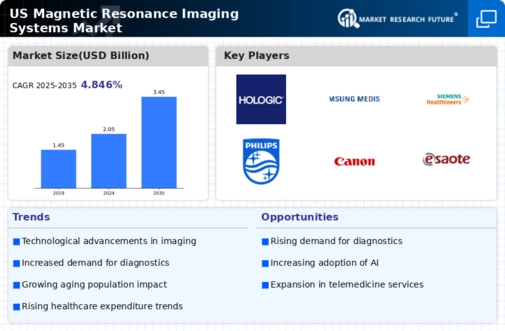The US Magnetic Resonance Imaging Systems Market is characterized by an intricate landscape of competition, driven by technological advancements and a growing demand for diagnostic imaging solutions. As healthcare professionals increasingly rely on MRI systems for their non-invasive imaging capabilities, the market has witnessed numerous strategic initiatives, partnerships, and innovations from key players. The competitive dynamics revolve around factors such as product quality, technological differentiation, and customer service excellence. Companies continually aim to enhance their offerings through research and development, navigating the complexities of regulation and market access while contending with emerging players that bring disruptive technologies to the forefront.
This evolving market reflects not only the traditional strengths of established industry leaders but also the agility of newer entrants, emphasizing the ongoing battle for market share and customer trust.
Hologic has firmified its presence within the US Magnetic Resonance Imaging Systems Market by leveraging its strengths in innovative technology and a strong product portfolio. The company is recognized for its commitment to enhancing imaging efficiency and patient outcomes through advanced MRI solutions designed to cater to a variety of clinical applications. With a focus on delivering high-resolution imaging and operational efficiency, Hologic capitalizes on its robust distribution network and extensive customer relationships. The company's ability to respond effectively to the needs of healthcare providers, along with its reputation for quality, positions Hologic as a significant player in the market.
Moreover, the firm actively pursues ongoing research and development to maintain its competitive edge and develop next-generation MRI technologies that align with evolving market demands.
Advanced Imaging Technologies operates within the competitive realm of the US Magnetic Resonance Imaging Systems Market, with a strong emphasis on innovative imaging solutions and customer-centered service. The company specializes in a range of MRI products and services that cater specifically to the unique requirements of healthcare providers in the US. Its robust market presence is bolstered by a commitment to high-quality imaging and fast turnaround times, ensuring reliability and efficiency for medical practitioners. Advanced Imaging Technologies is recognized for its strategic collaborations and potential mergers and acquisitions, which enhance its product offerings and expand its operational capabilities.
The company continuously seeks to align its services with the latest technological trends, ensuring that it remains relevant and responsive to the dynamic healthcare landscape. By focusing on quality and client satisfaction, Advanced Imaging Technologies has established itself as a viable competitor in the MRI systems market, propelling its growth and presence in the industry.




















Leave a Comment